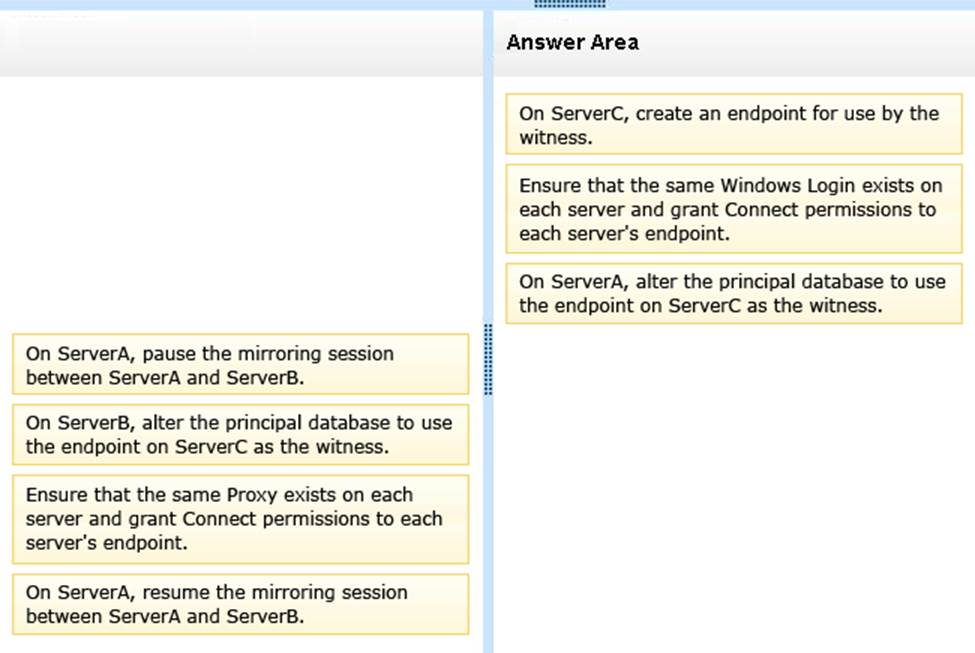Microsoft 70-462 Administering Microsoft SQL Server 2012 Databases Online Training
Microsoft 70-462 Online Training
The questions for 70-462 were last updated at Apr 19,2025.
- Exam Code: 70-462
- Exam Name: Administering Microsoft SQL Server 2012 Databases
- Certification Provider: Microsoft
- Latest update: Apr 19,2025
Topic 1, Exam Pool A
You administer all the deployments of Microsoft SQL Server 2012 in your company.
You need to ensure that an OLTP database that includes up-to-the-minute reporting requirements can be off-loaded from the primary database to another server. You also need to be able to add indexes to the secondary database.
Which configuration should you use?
- A . • Two servers configured in different data centers
• SQL Server Availability Group configured in Synchronous-Commit Availability Mode
• One server configured as an Active Secondary - B . • Two servers configured in the same data center
• SQL Server Availability Group configured in Asynchronous-Commit Availability Mode
• One server configured as an Active Secondary - C . • Two servers configured in the same data center
• A primary server configured to perform log-shipping every 10 minutes
• A backup server configured as a warm standby - D . • Two servers configured in different data centers
• SQL Server Availability Group configured in Asynchronous-Commit Availability Mode - E . • Two servers configured on the same subnet
• SQL Server Availability Group configured in Synchronous-Commit Availability Mode - F . • SQL Server that includes an application database configured to perform transactional replication
- G . • SQL Server that includes an application database configured to perform snapshot replication
- H . • Two servers configured in a Windows Failover Cluster in the same data center
• SQL Server configured as a clustered instance
You administer all the deployments of Microsoft SQL Server 2012 in your company.
You need to ensure that data changes are sent to a non-SQL Server database server in near real time.
You also need to ensure that data on the primary server is unaffected.
Which configuration should you use?
- A . • SQL Server that includes an application database configured to perform transactional replication
- B . • Two servers configured in different data centers
• SQL Server Availability Group configured in Asynchronous-Commit Availability Mode - C . • Two servers configured in different data centers
• SQL Server Availability Group configured in Synchronous-Commit Availability Mode
• One server configured as an Active Secondary - D . • SQL Server that includes an application database configured to perform snapshot replication
- E . • Two servers configured in the same data center
• SQL Server Availability Group configured in Asynchronous-Commit Availability Mode
• One server configured as an Active Secondary - F . • Two servers configured on the same subnet
• SQL Server Availability Group configured in Synchronous-Commit Availability Mode - G . • Two servers configured in a Windows Failover Cluster in the same data center
• SQL Server configured as a clustered instance - H . • Two servers configured in the same data center
• A primary server configured to perform log-shipping every 10 minutes
• A backup server configured as a warm standby
You administer all the deployments of Microsoft SQL Server 2012 in your company.
A database contains a large product catalog that is updated periodically.
You need to be able to send the entire product catalog to all branch offices on a monthly basis.
Which configuration should you use?
- A . • Two servers configured in the same data center
• A primary server configured to perform log-shipping every 10 minutes
• A backup server configured as a warm standby - B . • SQL Server that includes an application database configured to perform transactional replication
- C . • Two servers configured in the same data center
• SQL Server Availability Group configured in Asynchronous-Commit Availability Mode
• One server configured as an Active Secondary
D • Two servers configured in a Windows Failover Cluster in the same data center
• SQL Server configured as a clustered instance - D . • SQL Server that includes an application database configured to perform snapshot replication
- E . • Two servers configured in different data centers
• SQL Server Availability Group configured in Synchronous-Commit Availability Mode
• One server configured as an Active Secondary - F . • Two servers configured on the same subnet
• SQL Server Availability Group configured in Synchronous-Commit Availability Mode - G . • Two servers configured in different data centers
• SQL Server Availability Group configured in Asynchronous-Commit Availability Mode
Note: This question is part of a series of questions that use the same set of answer choices. An answer choice may be correct for more than one question in the series.
You administer all the deployments of Microsoft SQL Server in your company.
You need to ensure that an OLTP database that uses a storage area network (SAN) remains available if any of the servers fail.
You also need to minimize the amount of storage used by the database.
Which configuration should you use?
- A . • Two servers configured in different data centers
• SQL Server Availability Group configured in Synchronous-Commit Availability Mode
• One server configured as an Active Secondary - B . • SQL Server that includes an application database configured to perform transactional replication
- C . • Two servers configured in the same data center
• SQL Server Availability Group configured in Asynchronous-Commit Availability Mode
• One server configured as an Active Secondary - D . • Two servers configured in different data centers
• SQL Server Availability Group configured in Asynchronous-Commit Availability Mode - E . • Two servers configured in the same data center
• A primary server configured to perform log-shipping every 10 minutes
• A backup server configured as a warm standby - F . • Two servers configured on the same subnet
• SQL Server Availability Group configured in Synchronous-Commit Availability Mode - G . • SQL Server that includes an application database configured to perform snapshot replication
- H . • Two servers configured in a Windows Failover Cluster in the same data center
• SQL Server configured as a clustered instance
Note: This question is part of a series of questions that use the same set of answers choices. An answer choice may be correct for more than one question in the series.
You administer a Microsoft SQL Server that hosts a transactional database and a reporting database. The transactional database is updated through a web application and is operational throughout the day. The reporting database is only updated from the transactional database.
The recovery model and backup schedule are configured as shown in the following table:
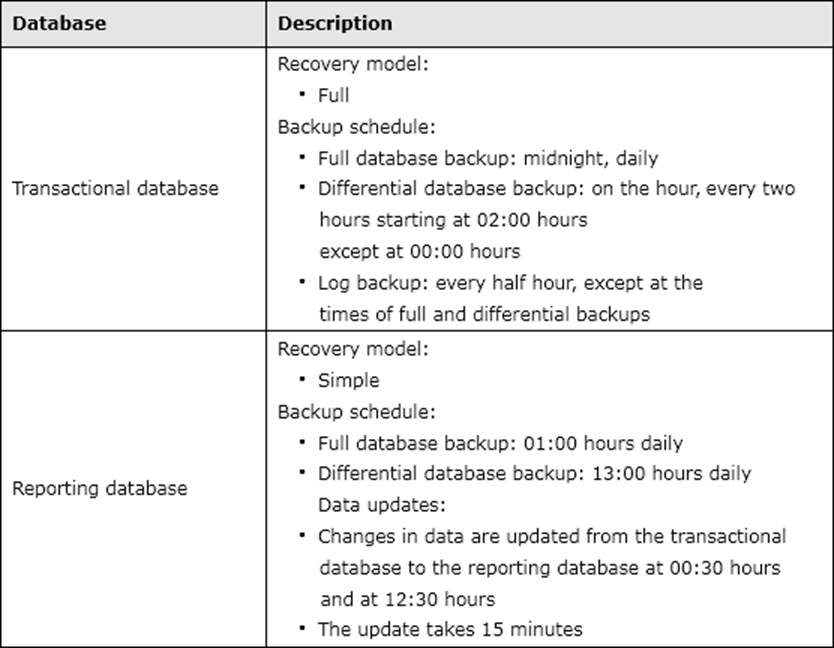
The differential backup of the reporting database fails. Then, the reporting database fails at 14:00 hours.
You need to ensure that the reporting database is restored. You also need to ensure that data loss is minimal.
What should you do?
- A . Restore the latest full backup, and restore the latest differential backup. Then, restore the latest log backup.
- B . Perform a point-in-time restore.
- C . Restore the latest full backup.
- D . Restore the latest full backup, and restore the latest differential backup. Then, restore each log backup taken before the time of failure from the most recent differential backup.
- E . Restore the latest full backup. Then, restore the latest differential backup.
- F . Restore the latest full backup. Then, restore each differential backup taken before the time of failure from the most recent full backup.
- G . Perform a page restore.
- H . Perform a partial restore.
Note: This question is part of a series of questions that use the same set of answers choices. An answer choice may be correct for more than one question in the series.
You administer a Microsoft SQL Server that hosts a transactional database and a reporting database. The transactional database is updated through a web application and is operational throughout the day. The reporting database is only updated from the transactional database.
The recovery model and backup schedule are configured as shown in the following table:
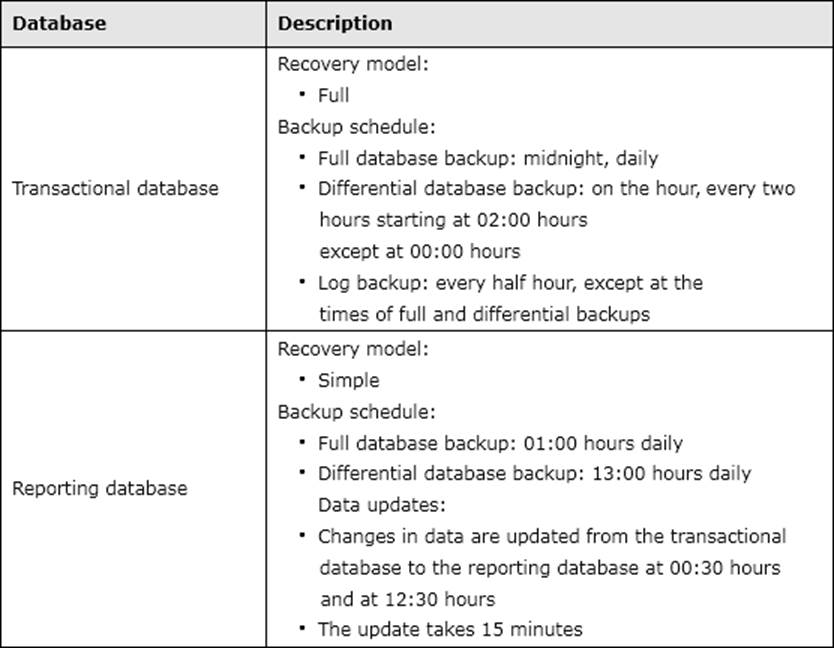
At 14:00 hours, you discover that pages 71, 520, and 713 on one of the database files are corrupted on the reporting database.
You also need to ensure that data loss is minimal.
What should you do?
- A . Perform a partial restore.
- B . Restore the latest full backup, and restore the latest differential backup. Then, restore each log backup taken before the time of failure from the most recent differential backup.
- C . Restore the latest full backup.
- D . Restore the latest full backup, and restore the latest differential backup. Then, restore the latest log backup.
- E . Perform a page restore.
- F . Restore the latest full backup. Then, restore each differential backup taken before the time of failure from the most recent full backup.
- G . Perform a point-in-time restore.
- H . Restore the latest full backup. Then, restore the latest differential backup.
Note: This question is part of a series of questions that use the same set of answers choices. An answer choice may be correct for more than one question in the series.
You administer a Microsoft SQL Server that hosts a transactional database and a reporting database. The transactional database is updated through a web application and is operational throughout the day. The reporting database is only updated from the transactional database.
The recovery model and backup schedule are configured as shown in the following table:
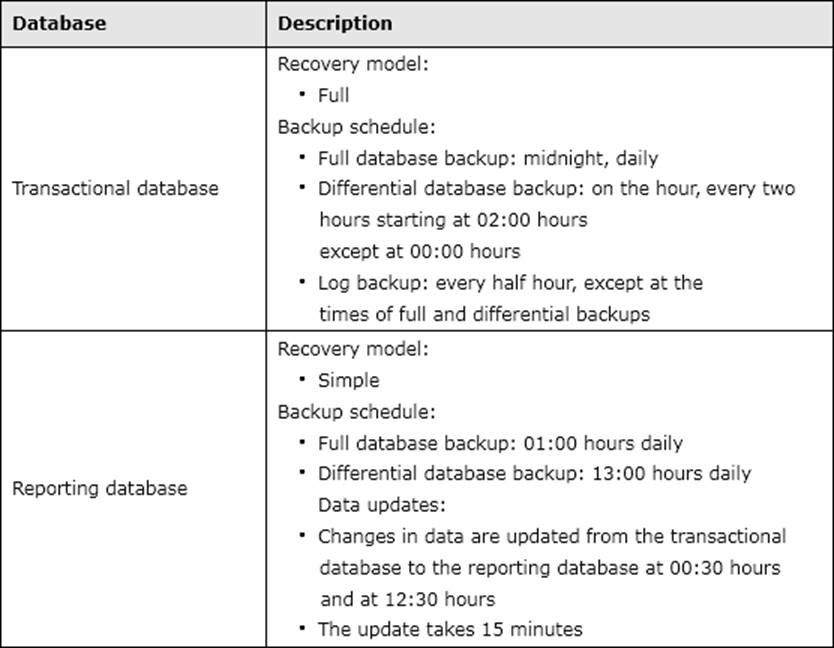
At 16:20 hours, you discover that pages 17, 137, and 205 on one of the database files are corrupted on the transactional database.
You need to ensure that the transactional database is restored.
You also need to ensure that data loss is minimal.
What should you do?
- A . Perform a partial restore.
- B . Restore the latest full backup, and restore the latest differential backup. Then, restore each log backup taken before the time of failure from the most recent differential backup.
- C . Perform a point-in-time restore.
- D . Restore the latest full backup.
- E . Restore the latest full backup, and restore the latest differential backup. Then, restore the latest log backup.
- F . Perform a page restore.
- G . Restore the latest full backup. Then, restore each differential backup taken before the time of failure from the most recent full backup.
- H . Restore the latest full backup. Then, restore the latest differential backup.
Note: This question is part of a series of questions that use the same set of answers choices. An answer choice may be correct for more than one question in the series.
You administer a Microsoft SQL Server that hosts a transactional database and a reporting database. The transactional database is updated through a web application and is operational throughout the day. The reporting database is only updated from the transactional database.
The recovery model and backup schedule are configured as shown in the following table:
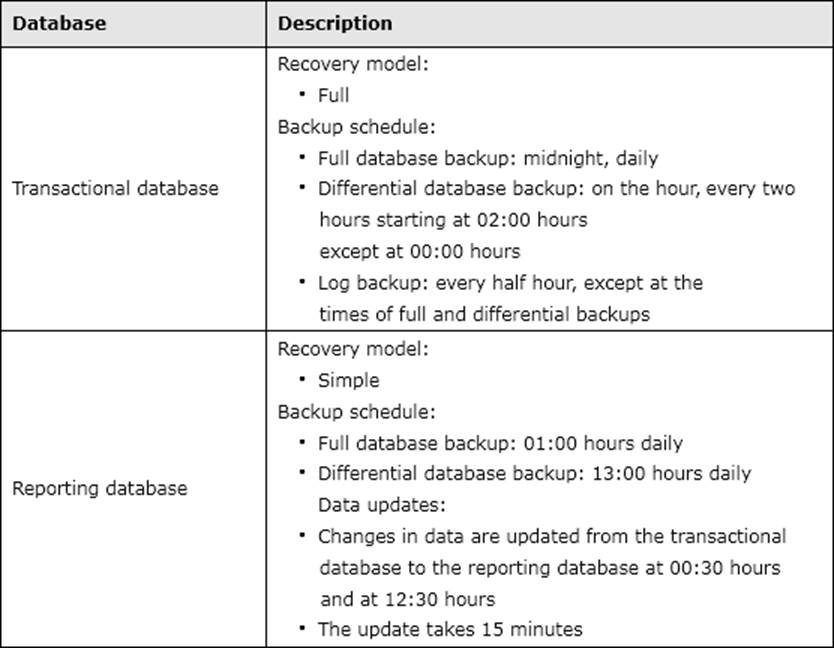
One of the hard disk drives that stores the reporting database fails at 16:40 hours.
You need to ensure that the reporting database is restored. You also need to ensure that data loss is minimal.
What should you do?
- A . Restore the latest full backup. Then, restore each differential backup taken before the time of failure from the most recent full backup.
- B . Perform a partial restore.
- C . Restore the latest full backup, and restore the latest differential backup. Then, restore the latest log backup.
- D . Perform a point-in-time restore.
- E . Restore the latest full backup.
- F . Perform a page restore.
- G . Restore the latest full backup, and restore the latest differential backup. Then, restore each log backup taken before the time of failure from the most recent differential backup.
- H . Restore the latest full backup. Then, restore the latest differential backup.
DRAG DROP
You administer three Microsoft SQL Server 2012 servers named ServerA, ServerB, and ServerC. ServerA is the acting principal and ServerB is the mirror.
You need to add ServerC as a witness to the existing mirroring session between ServerA and ServerB.
You need to achieve this goal without delaying synchronization.
Which three actions should you perform in sequence? (To answer, move the appropriate actions from the list of actions to the answer area and arrange them in the correct order.)
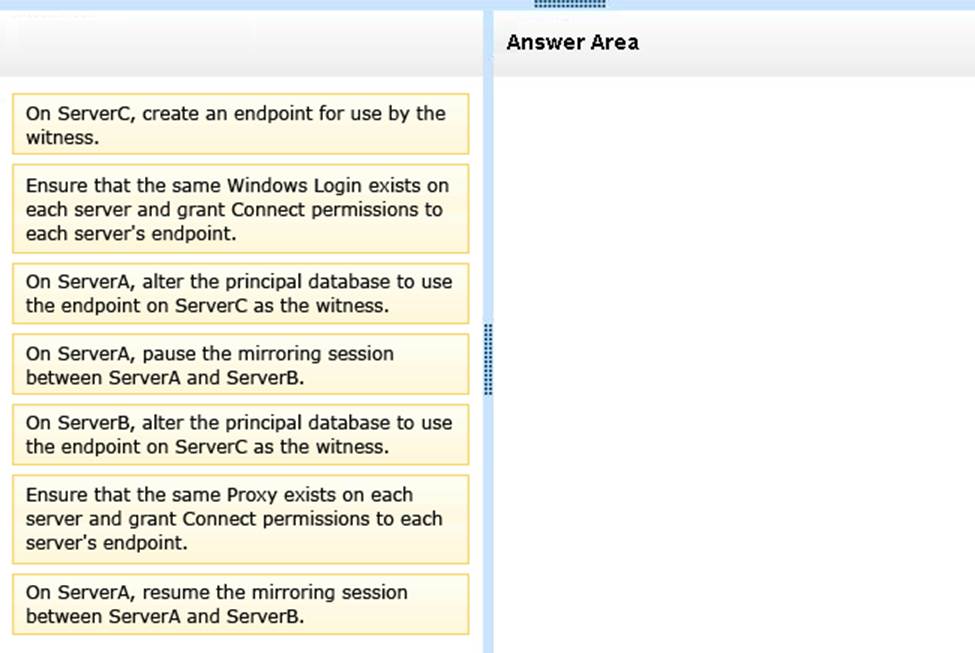
You administer a Microsoft SQL Server database.
You create an availability group named haContosoDbs. Your primary replica is available at Server01Contoso01. You need to configure the availability group to prevent data loss. In the event of a database failure,
the designed secondary database must come online automatically.
Which Transact-SQL statement should you use?
- A . ALTER AVAILABILITY GROUP haContosoDbs MODITY REPLICA ON ‘Server01’Contoso01’WITH (AVAILABILITY _MODE=ASYNCHRONOUS_COMMIT, FAILOVER_MODE=AUTOMATIC)
- B . ALTER AVAILABILITY GROUP haContosoDbs MODIFY REPLICA ON ‘Server01’Contoso01’WITH (AVAILABILITY _MODE=ASYNCHRONOUS_COMMIT, FAILOVER_MODE=MANUAL)
- C . ALTER AVAILABILITY GROUP haContosoDbs MODITY REPLICA ON ‘Server01’Contoso01’WITH (AVAILABILITY _MODE=SYNCHRONOUS_COMMIT, FAILOVER_MODE=AUTOMATIC)
- D . ALTER AVAILABILITY GROUP haContosoDbs MODIFY REPLICA ON ‘Server01’Contoso01’WITH (AVAILABILITY _MODE=SYNCHRONOUS_COMMIT, FAILOVER_MODE=MANUAL)
Latest 70-462 Dumps Valid Version with 301 Q&As
Latest And Valid Q&A | Instant Download | Once Fail, Full Refund

